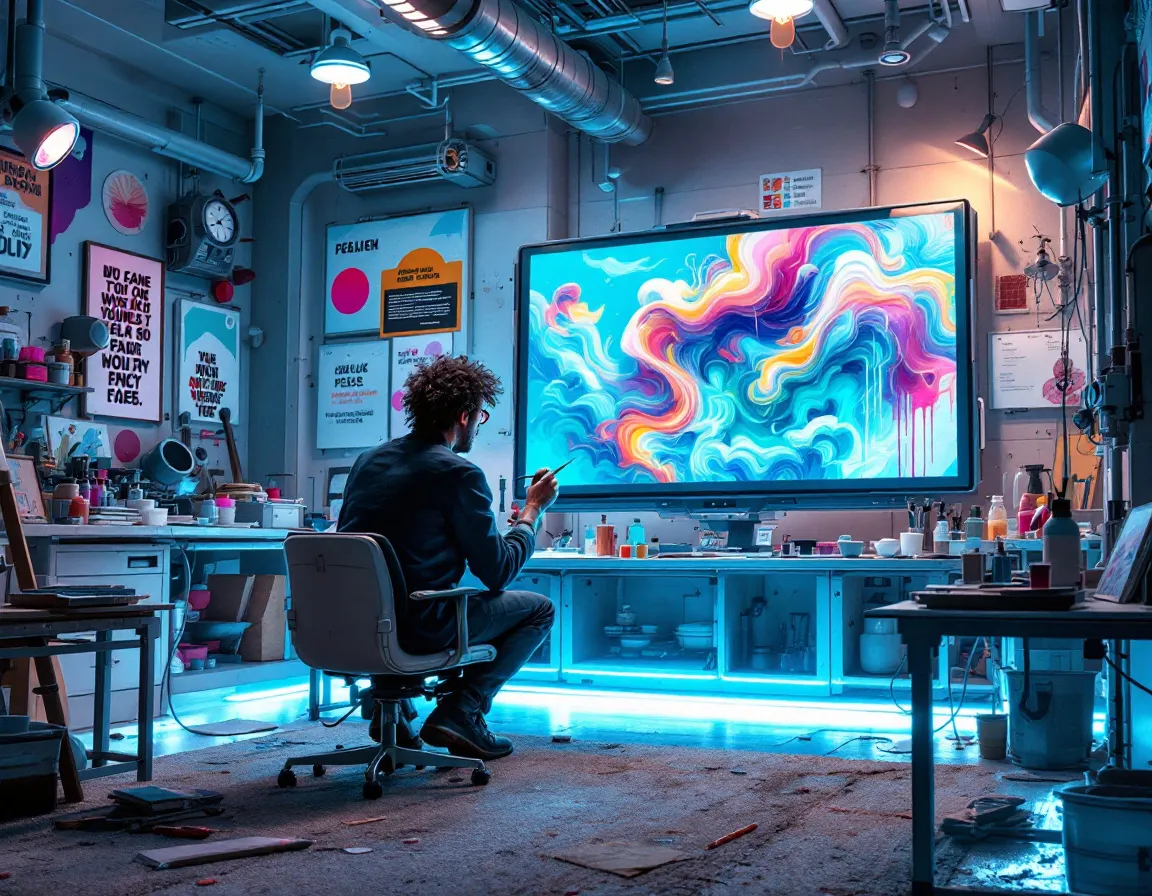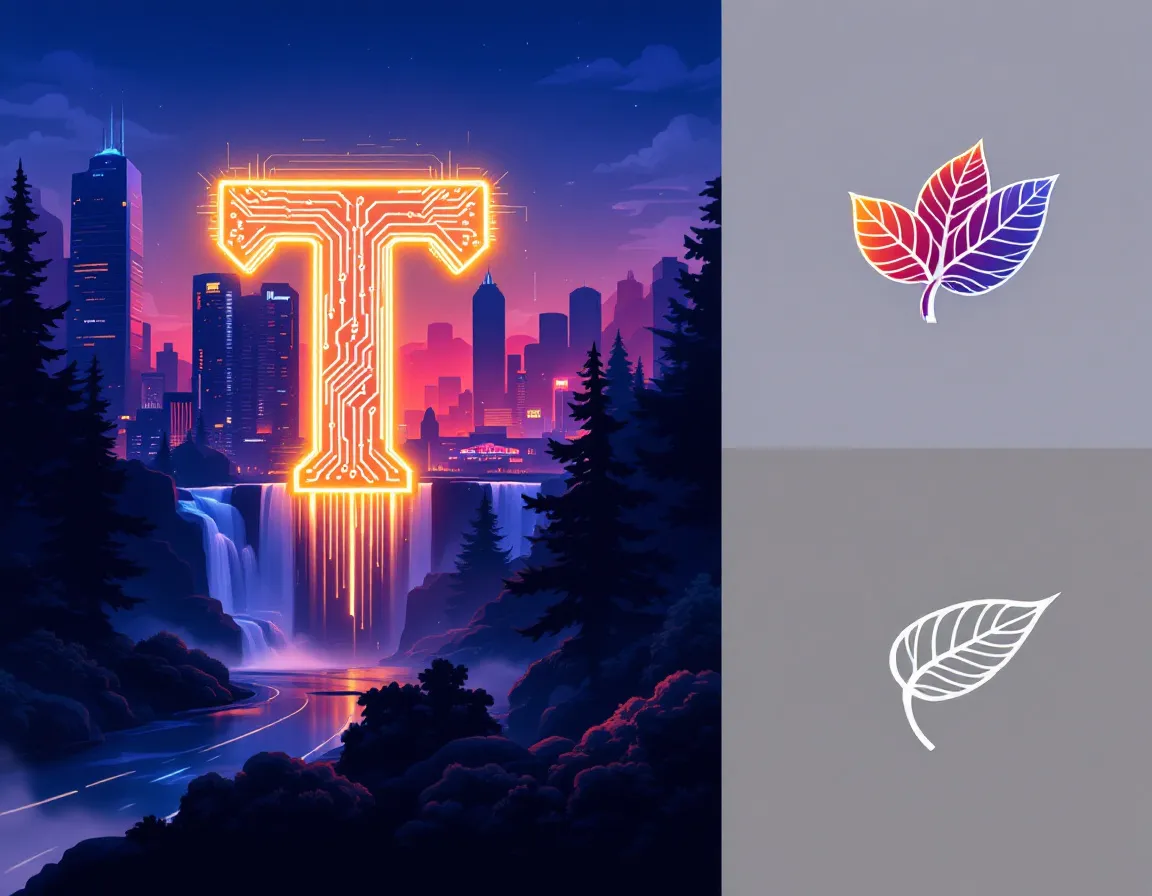Finding the perfect logo inspiration can transform a good brand into an unforgettable one. Whether you’re browsing through Dribbble logo examples or studying iconic designs on Logopond, understanding what makes a logo truly remarkable is crucial for creating lasting brand identities.
This comprehensive guide will walk you through the fundamentals of logo design, exploring both timeless principles and cutting-edge trends.
Understanding Logo Design Fundamentals
What Makes a Logo Effective
At its core, an effective logo must achieve several key objectives. It should be distinctive, scalable, and versatile while conveying the brand’s essence in a single glance. The most memorable logos strike a delicate balance between simplicity and sophistication, using carefully chosen elements to create lasting impressions. For tips on achieving this balance, consider exploring our photo editing guide.
Consider these fundamental principles:
- Simplicity: Clean designs that work across multiple platforms
- Memorability: Unique elements that stick in viewers’ minds
- Versatility: Adaptability across different mediums and sizes
- Relevance: Connection to the brand’s values and industry
- Timelessness: Design that transcends current trends
The Evolution of Logo Design
The history of logo design reflects the evolution of visual communication itself. From intricate Victorian-era emblems to today’s minimalist marks, logo design has continuously adapted to changing technologies and cultural preferences. Perhaps no example better illustrates this evolution than the Nike swoosh story. For more on cultural influences, visit our 90s slang words blog.
In 1971, graphic design student Carolyn Davidson created the Nike swoosh for just $35. Inspired by the wing of Nike, the Greek goddess of victory, this simple curve has become one of the most recognized symbols worldwide. When Phil Knight first saw the design, he famously remarked, “I don’t love it, but it will grow on me” – a testament to how even iconic logos sometimes need time to reveal their true potential.
Where to Find Logo Inspiration

Online Design Communities
Modern designers have unprecedented access to logo inspiration through various online platforms. Dribbble stands out as a premier destination, featuring countless logo examples from top designers worldwide. The platform’s “99 logos” collections and curated galleries provide fresh perspectives and current trends in logo design. For more insights, check out our Instagram guide.
Key platforms for logo inspiration include:
- Dribbble: Professional designers showcasing their best work
- Logopond: Dedicated to logo design and branding
- Behance: Comprehensive brand identity projects
- Instagram: Trending designs under #logoinspo hashtags
- Reddit logos: Community discussions and feedback
Industry-Specific Logo Galleries
Different industries often require distinct approaches to logo design. Tech companies typically favor modern, clean aesthetics, while food and beverage brands might opt for more organic, approachable designs. Studying industry-specific galleries can provide targeted inspiration for your particular niche.
Natural and Cultural Sources
Looking beyond digital platforms, inspiration can come from unexpected sources. Architecture offers lessons in structure and proportion, while nature provides endless examples of organic forms and color combinations. Cultural symbols can add depth and meaning to logo designs, though they must be used thoughtfully and respectfully. For more on cultural design, explore our photography props blog.
Types of Logo Inspiration
Minimalist Logos
The minimalist approach to logo design continues to gain popularity, especially in digital environments where clarity at small sizes is crucial. Successful minimalist logos strip away unnecessary elements while maintaining brand recognition. Companies like Apple and Twitter have mastered this approach, creating instantly recognizable symbols with minimal elements.
Key principles of minimalist logo design:
- Remove unnecessary elements
- Focus on essential shapes
- Use negative space effectively
- Maintain perfect proportion
- Ensure scalability
Typography-Based Logos
Typography-based logos, or wordmarks, rely on carefully crafted lettering to create distinctive brand identities. The success of these logos depends heavily on font selection or custom typography development. Companies like Coca-Cola and Google demonstrate how effective typography can become a powerful brand asset.
When developing typography-based logos, consider:
- Font personality and brand alignment
- Legibility across different sizes
- Custom modifications for uniqueness
- Letter spacing and kerning
- Color and contrast relationships
Symbolic and Abstract Logos
Symbolic and abstract logos can transcend language barriers and cultural differences. These designs often become powerful brand assets by creating unique visual associations. The challenge lies in developing symbols that are both meaningful and memorable without being too literal or complex.
The most successful abstract logos share these characteristics:
- Strong visual impact
- Meaningful symbolism
- Cultural sensitivity
- Versatile application
- Distinctive silhouette
This exploration of logo inspiration fundamentals sets the stage for deeper understanding of how successful brands develop their visual identities. In the following sections, we’ll examine specific techniques, tools, and trends that can help you create more effective logo designs.
Where to Find Logo Inspiration
Finding the perfect logo inspiration requires knowing where to look. Today’s digital landscape offers countless resources for designers and brands seeking fresh ideas and creative direction. From established platforms like Dribbble to emerging communities, let’s explore the most valuable sources of logo inspiration.
Online Design Communities
Dribbble stands as the premier destination for logo inspiration, featuring over 1 million design professionals sharing their work. The platform’s curated approach ensures high-quality submissions, with features like “Popular Shots” highlighting trending logo designs. Users can filter by color, style, and industry to find relevant inspiration quickly. For more on digital design, visit our AI video generator blog.
Beyond Dribbble, Logopond offers a dedicated space for logo designers to showcase their work. What sets Logopond apart is its focus on constructive feedback and iteration, allowing viewers to see how logos evolve through community input. The platform’s “Featured” section spotlights exceptional examples of logo design principles in action.
99 Logos provides a unique perspective by featuring both professional and experimental designs. This diversity helps brands understand the full spectrum of possibilities within logo design, from minimalist approaches to complex illustrations.
Industry-Specific Logo Galleries
Tech sector innovations have given rise to distinctive logo trends. Companies like Slack and Airbnb showcase how modern brands use adaptive logos that work across multiple platforms while maintaining brand recognition. The tech industry’s approach to logo design often emphasizes scalability and digital-first functionality.
Food and beverage brands require unique considerations in their logo design. Successful examples include:
- Starbucks’ evolution from detailed illustration to simplified icon
- Coca-Cola’s timeless script typography
- Whole Foods’ integration of natural elements
Natural and Cultural Sources
Architecture provides rich logo inspiration through its geometric patterns and structural elements. The Amazon smile logo, for instance, draws from architectural principles of connection and direction. Similarly, the Chase bank logo uses octagonal symmetry inspired by architectural forms. For more on design techniques, explore our teeth whitening in photos blog.
Nature-inspired designs continue to influence modern logos, offering organic shapes and color palettes that resonate with audiences. The WWF panda logo exemplifies how natural elements can create powerful, lasting brand identities.
Types of Logo Inspiration
Minimalist Logos
Minimalist design principles have dominated logo trends in recent years. Apple’s iconic fruit silhouette demonstrates how simplicity can create lasting impact. The key elements of successful minimalist logos include:
- Limited color palette (often monochromatic)
- Clean, essential shapes
- Removal of unnecessary details
- Focus on negative space
Typography-Based Logos
The Instagram logo evolution showcases how typography can adapt while maintaining brand recognition. When creating typography-based logos, designers consider:
- Font personality and brand alignment
- Legibility across platforms
- Custom letterform modifications
- Spacing and kerning details
Symbolic and Abstract Logos
The Nike swoosh story perfectly illustrates the power of symbolic logos. Created for just $35 by graphic design student Carolyn Davidson in 1971, the swoosh symbolizes the wing of Nike, the Greek goddess of victory. Initially met with uncertainty, it has become one of the most recognized logos globally.
Reddit’s alien mascot “Snoo” demonstrates how abstract logos can create strong brand communities. The character’s simple design allows for endless variations while maintaining core recognition.
Creative Process and Methodology

Research and Discovery
Effective logo design begins with thorough market analysis. Designers must understand:
- Target audience demographics and preferences
- Competitor visual strategies
- Industry-specific design conventions
- Cultural considerations and implications
Brainstorming Techniques
Professional designers use structured approaches to generate logo inspiration:
- Mind mapping: connecting brand attributes with visual elements
- Mood boards: collecting visual references and style directions
- Rapid sketching: exploring multiple concepts quickly
- Word association: linking brand values to visual concepts
The design process often involves digital tools like Adobe Illustrator for vector creation, but initial concepts typically start with pencil and paper. This traditional approach allows for quick iteration and organic exploration of ideas.
Modern Logo Design Trends
Current Design Movements
Contemporary logo design embraces adaptability and motion. Brands increasingly require logos that work across various platforms and contexts. Key trends include:
- Responsive design elements that adjust to different screen sizes
- Animated versions for digital platforms
- Simplified forms that maintain recognition at small scales
- Variable logos that change based on context
Technology Integration
Artificial intelligence tools now assist in logo design, offering quick iterations and suggestions. However, human creativity remains essential for developing truly unique and meaningful logos. The best results often come from combining technological capabilities with traditional design expertise. For more on AI in design, visit Smashing Magazine’s article on logo design principles.
As we move forward, successful logo design will continue to balance timeless principles with modern innovations. The key lies in creating designs that remain relevant while adapting to new technological possibilities and changing consumer expectations.
Logo Inspiration for Different Industries

Finding the right logo inspiration requires understanding industry-specific considerations and visual languages. Different sectors demand distinct approaches to logo design, reflecting their unique values and target audiences.
Sector-Specific Considerations
Tech startups often gravitate toward minimalist, forward-thinking designs that convey innovation. Companies like Slack and Dropbox exemplify this approach with their simple yet distinctive logos. The tech sector frequently draws logo inspiration from geometric shapes and abstract concepts, creating memorable brand identities on platforms like Dribbble and Logopond.
Retail and consumer goods brands typically focus on approachable, emotionally resonant designs. Target’s iconic bullseye and Amazon’s smile arrow demonstrate how simple elements can create powerful brand recognition. These logos often appear in curated collections on 99logos and similar platforms, serving as inspiration for emerging brands.
Professional services require logos that convey trust and expertise. Law firms, consulting agencies, and financial institutions often opt for typography-based logos with refined color palettes. The Instagram logo evolution from a detailed camera to its current gradient design shows how even professional brands can modernize while maintaining their core identity. For more on branding strategies, check out Forbes’ article on branding strategies.
Industry-Specific Examples
Healthcare organizations balance professionalism with compassion in their logo designs. The Red Cross symbol remains one of the most recognized healthcare logos globally, inspiring countless medical brands. Modern healthcare logos often incorporate elements like the caduceus or heart shapes while maintaining clean, professional aesthetics.
Educational institutions frequently combine traditional elements with contemporary design principles. University shields and crests evolve into simplified versions that work across digital platforms. Many find inspiration from Reddit logos discussions, where designers share innovative approaches to academic branding.
Future of Logo Design
Emerging Trends
AI-generated logos are revolutionizing the design landscape. Tools powered by artificial intelligence can now create unique logo variations based on brand parameters, though they haven’t replaced human creativity. This technology serves as a powerful source of logo inspiration, generating unexpected combinations and concepts.
Interactive brand identities are gaining prominence, with logos adapting to different contexts and user interactions. Companies like Google demonstrate this through their dynamic doodles, while maintaining their core logo recognition. These adaptive designs frequently appear on Dribble logo showcases, inspiring designers to push creative boundaries. For more examples of branding excellence, explore Creative Bloq’s branding designs.
Preparing for Future Changes
Successful brands are developing adaptability strategies for their logos across emerging platforms and technologies. Virtual and augmented reality present new challenges and opportunities for logo display and interaction. Forward-thinking designers are already experimenting with dimensional logos that maintain their impact across traditional and digital spaces.
Practical Tips and Best Practices
Common Mistakes to Avoid
Over-complexity remains a common pitfall in logo design. The Nike swoosh story perfectly illustrates the power of simplicity – created for just $35 by graphic design student Carolyn Davidson, it’s now one of the world’s most valuable brand assets. This example continues to provide logo inspiration for designers advocating minimalist approaches.
Following trends blindly can lead to dated designs. While it’s important to stay current, successful logos balance contemporary elements with timeless principles. The best logo examples maintain their relevance through careful consideration of brand values and target audience needs.
Implementation Guidelines
Technical considerations play a crucial role in successful logo design. Ensure logos work across various sizes and applications:
– Create vector-based designs for scalability
– Test logos in both color and monochrome
– Verify legibility at different dimensions
– Consider responsive variations for digital platforms
Color space considerations affect logo reproduction across different media. Develop guidelines for:
– CMYK values for print applications
– RGB codes for digital display
– Pantone colors for consistent branding
– Acceptable color variations and alternatives
Conclusion: Creating Lasting Logo Inspiration
The journey of logo design continues to evolve with technology and cultural shifts. Successful logos balance artistic vision with practical application, drawing inspiration from various sources while maintaining originality. Whether browsing through logo design images on professional platforms or studying iconic brand evolutions, remember that lasting logo designs often emerge from understanding fundamental principles rather than following temporary trends.
The future of logo inspiration lies in the intersection of creativity and functionality. As new platforms emerge and consumer expectations evolve, logos must adapt while maintaining their core purpose – creating memorable brand identities that resonate with audiences across all touchpoints.
Whether you’re a designer seeking fresh ideas or a brand owner planning a logo redesign, remember that the best logo inspiration often comes from understanding your unique brand story and audience needs. The most successful logos, like the Nike swoosh, prove that sometimes the simplest solutions create the most powerful and enduring brand identities.
Check out ProductScope AI’s Free AI Logo Generator (get 200 free studio credits)
